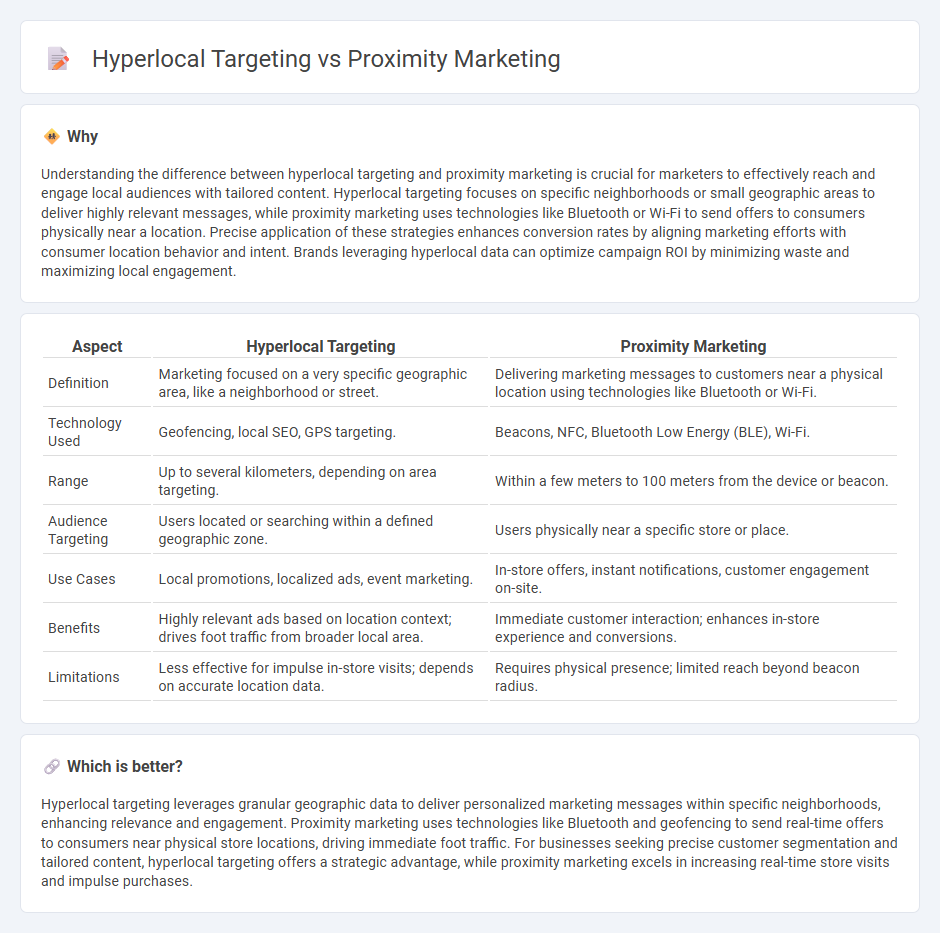
Hyperlocal targeting focuses on delivering highly personalized marketing messages to consumers within a very specific geographic area, often down to individual neighborhoods or blocks. Proximity marketing leverages technologies like Bluetooth, Wi-Fi, or geofencing to send targeted promotions to customers when they enter or are near a specific location. Discover how these strategies can enhance customer engagement and drive sales through spatial precision.
Why it is important
Understanding the difference between hyperlocal targeting and proximity marketing is crucial for marketers to effectively reach and engage local audiences with tailored content. Hyperlocal targeting focuses on specific neighborhoods or small geographic areas to deliver highly relevant messages, while proximity marketing uses technologies like Bluetooth or Wi-Fi to send offers to consumers physically near a location. Precise application of these strategies enhances conversion rates by aligning marketing efforts with consumer location behavior and intent. Brands leveraging hyperlocal data can optimize campaign ROI by minimizing waste and maximizing local engagement.
Comparison Table
| Aspect | Hyperlocal Targeting | Proximity Marketing |
|---|---|---|
| Definition | Marketing focused on a very specific geographic area, like a neighborhood or street. | Delivering marketing messages to customers near a physical location using technologies like Bluetooth or Wi-Fi. |
| Technology Used | Geofencing, local SEO, GPS targeting. | Beacons, NFC, Bluetooth Low Energy (BLE), Wi-Fi. |
| Range | Up to several kilometers, depending on area targeting. | Within a few meters to 100 meters from the device or beacon. |
| Audience Targeting | Users located or searching within a defined geographic zone. | Users physically near a specific store or place. |
| Use Cases | Local promotions, localized ads, event marketing. | In-store offers, instant notifications, customer engagement on-site. |
| Benefits | Highly relevant ads based on location context; drives foot traffic from broader local area. | Immediate customer interaction; enhances in-store experience and conversions. |
| Limitations | Less effective for impulse in-store visits; depends on accurate location data. | Requires physical presence; limited reach beyond beacon radius. |
Which is better?
Hyperlocal targeting leverages granular geographic data to deliver personalized marketing messages within specific neighborhoods, enhancing relevance and engagement. Proximity marketing uses technologies like Bluetooth and geofencing to send real-time offers to consumers near physical store locations, driving immediate foot traffic. For businesses seeking precise customer segmentation and tailored content, hyperlocal targeting offers a strategic advantage, while proximity marketing excels in increasing real-time store visits and impulse purchases.
Connection
Hyperlocal targeting and proximity marketing both focus on delivering personalized content to consumers based on their exact geographic location, leveraging technologies like GPS, Wi-Fi, and Bluetooth. These strategies enhance customer engagement by providing relevant offers and information within a specific radius, increasing conversion rates for local businesses. Integration of hyperlocal data enables marketers to optimize campaign effectiveness through precise audience segmentation and timely message delivery.
Key Terms
**Proximity Marketing**
Proximity marketing leverages technologies like Bluetooth, Wi-Fi, and NFC to deliver location-based advertisements and notifications to consumers when they are near a specific physical location, enhancing personalized engagement and increasing conversion rates. This strategy is commonly used in retail environments, events, and airports to boost foot traffic and provide timely offers or information to potential customers. Explore how proximity marketing can transform your brand's local outreach and customer interaction.
Bluetooth Beacons
Proximity marketing leverages Bluetooth beacons to deliver personalized content and offers directly to users' devices within a specific range, enhancing real-time engagement in physical locations. Hyperlocal targeting, while also utilizing Bluetooth beacons, focuses more precisely on micro-geographical areas like individual stores or city blocks to optimize customer reach and increase conversion rates. Explore how integrating Bluetooth beacon technology in your marketing strategy can boost local customer interaction and sales effectiveness.
Geofencing
Geofencing leverages location-based technology to create virtual boundaries around specific geographic areas, enabling proximity marketing to deliver targeted ads to users within these zones. Hyperlocal targeting refines this approach by focusing on a much smaller radius, such as individual neighborhoods or even specific stores, increasing relevance and engagement through precise consumer location data. Explore how geofencing can transform your marketing strategy with advanced hyperlocal targeting techniques.
Source and External Links
Proximity Marketing: Engaging at the Right Place and Time - Proximity marketing uses location technologies like Bluetooth, NFC, and Wi-Fi to send targeted, relevant marketing messages to customers' mobile devices when they are near a business, enhancing customer experience and increasing sales likelihood.
Proximity Marketing - Definition, Benefits & Beacons - It is a marketing technique that delivers personalized content to customers based on their location using methods such as Wi-Fi, GPS geofencing, NFC, and Bluetooth beacons to improve engagement and conversions.
3 Proximity Marketing Examples: What Markets Need - Proximity marketing efficiently helps industries like retail and hospitality by sending targeted offers (e.g., discounts via beacons) directly to devices near a business, allowing personalized interaction and competitive advantage at low cost.
 dowidth.com
dowidth.com